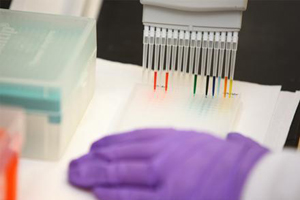Research Supporting the Endocrine Disruptor Screening Program
On this page:
- Prioritizing Chemicals for Potential Endocrine Disruption
- In-Depth Testing for Potential Endocrine Disruption
Prioritizing Chemicals for Potential Endocrine Disruption
EPA’s current endocrine disruption tests do a thorough job of screening chemicals but they are low throughput and expensive (50-100 chemicals per year at a cost of approximately $1 million per chemical). Given this limitation, EPA researchers have been developing new rapid methods that can quickly screen thousands of chemicals. Chemicals that may have an effect on hormonal systems and lead to endocrine disruption can often be identified by assessing how they interact with the estrogen receptor, androgen receptor and the thyroid.

EPA researchers developed a number of innovative screening tests to prioritize potential endocrine disrupting chemicals. Positive results on these tests suggest that the chemical may mimic the actions of estrogen in the body and lead to endocrine disruption. These rapid methods often called "high-throughput” are most fully developed for detecting disruptions in the estrogen pathway.
With input from a Scientific Advisory Panel, EPA determines which of these new methods can be used to screen and prioritize chemicals for endocrine disruption. EPA researchers are also researching a chemical's potential to disrupt two other hormonal systems: the androgen hormones that direct male reproductive development and activities, and thyroid hormones.
High-throughput testing to evaluate chemicals for androgen disruption is underway and methods for thyroid hormones are being planned. Systems biology approaches such as adverse outcome pathways and graphical systems models are also being developed to help predict if a chemical is an endocrine disrupting chemical.
New Methods:
- ToxCast: EPA’s High-Throughput Screening Research
- ExpoCast: EPA’s High-Throughput Exposure Estimation Research
- Exposure Analysis Modeling System (EXAMS)
In-Depth Testing for Potential Endocrine Disruption
EPA researchers develop methods for testing chemicals for potential endocrine disruption. These tests range from tests on animals to chemical assays (in a test tube or chemical well plate). EPA researchers have developed whole-animal tests, such as a 21-day test which is now being used as part of the EPA's endocrine disruptor screening program's Tier 1 tests.
21-Day Test on Fathead Minnows
This 21-day test on fathead minnows is designed to detect changes in fish and their spawning behavior, as well as specific biochemical endpoints that reflect disturbances in hormonal systems. The results of this test are useful for assessing potential effects of a chemical or mixture of chemicals on aquatic organisms and in some cases human health as well, given that fish and humans have similarities in their reproductive hormonal systems.
Protocols for Tier 2 Testing
EPA researchers have also developed protocols for Tier 2 testing to assess how chemicals affect the endocrine system of fish and amphibians. For fish, scientists created the Medaka Multi-Generation Test. This test provides concentration-response information related to the adverse effects in fish after they are exposed to various concentrations of potential endocrine disrupting chemicals in water. Examples of adverse effects are changes to the integrity and performance of male and female reproductive systems, including fertility, secondary sex characteristics, etc.
Amphibian Tests
For amphibians, scientists constructed the Larval Amphibian Growth and Development Test. This test provides concentration-response information related to the adverse effects in amphibians after they are exposed to various concentrations of potential endocrine disrupting chemicals in water. After input from a Scientific Advisory Panel, the two tests can be used to determine if chemicals identified by Tier 1 tests may pose a risk to the endocrine system of fish, amphibians and other aquatic species found in lakes, streams and rivers.
